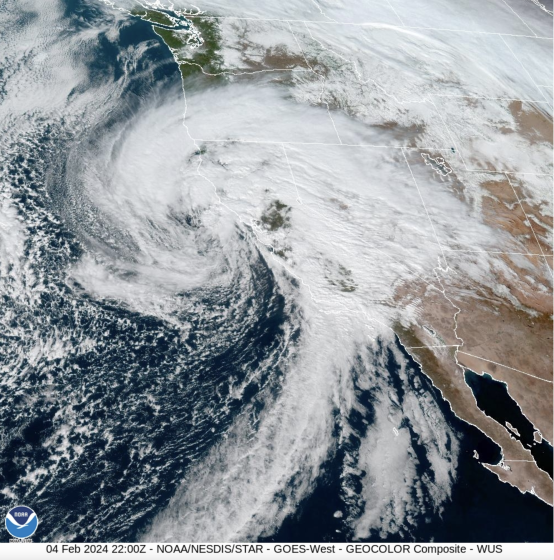How a 'bomb cyclone' helped fuel California's deadly storm

The deadly storm that is walloping California with hurricane-force winds and record amounts of rainfall was fueled in part by the powerful weather phenomenon known as a "bomb cyclone," according to the National Weather Service office in Monterey, Calif.
"For those keeping score, it also looks like it reached 'bomb' status," a weather service forecast issued Sunday evening said.
The meteorologists who took over on Monday morning clarified that their colleagues were talking about "Bomb, meaning the intensity of the low pressure, not bomb meaning awesome."
The meteorological term is reserved for rapidly intensifying storms that undergo a steep drop in pressure over 24 hours. That matters because wind and severe weather tends to move from areas of high pressure to low pressure.
The result is blustery conditions converging on the center of bomb cyclones. In the San Francisco Bay Area, wind gusts from the storm exceeded 100 mph and unleashed about 8 inches of rain.
Read more: Deadly storm continues to batter Southern California amid new flood, mudslide fears
But it's not the severity that earns a storm the bomb cyclone label. Rather, the designation refers to the rate at which the storm intensifies, said Dalton Behringer, a meteorologist with the National Weather Service office in Monterey.
"It's really just a measure of how quickly the storm has strengthened," Behlinger said. "Essentially, there's a speed limit. But this means the storm is going to reach the speed limit faster."
To qualify as a bomb cyclone, a storm's central pressure must drop by a certain amount in a 24-hour period. In the Bay Area, the benchmark is 17 millibars. The meteorologists tracking the storm Sunday observed its pressure drop by between 19 and 21 millibars.
Read more: California storm: After 5 days, the rain has stopped. In its wake, 9 dead, a trail of destruction
The storm produced gusts as high as 102 mph at Pablo Point in Marin County. Weather forecasters received numerous reports of downed redwood and eucalyptus trees, some of which came crashing into homes. The storm damage also left hundreds of thousands without power, while falling trees resulted in at least three deaths.
Bomb cyclone storms are common in the winter months, though they sometimes go unrecognized when they occur over ocean waters. At least two bomb cyclone storms drubbed the Bay Area last year, including one in March that resulted in multiple deaths.
The term "bomb cyclone" was coined by a pair of MIT meteorologists in a 1980 research paper published in Monthly Weather Review. It didn't catch on with the public until January 2018, when a powerful storm blitzed the Northeast.
Read more: Five days, up to 14 inches of rain: See the totals from a drenching few days in Southern California
The phrase is rooted in the word "bombogenesis," which meteorologists and atmospheric scientists have been using since the 1940s, said Daniel Swain, a UCLA climate scientist.
"I think this largely came from the notion that some storms developed explosively, not literally like a bomb," he said in a Monday briefing.
But it's certainly more than a figure of speech. Swain emphasized that he didn't want any surfers to misconstrue the intensity of the storm.
"'Bomb' in this context does not mean a 'bomb' as in, 'That's so bomb,' 'That's so cool,' 'That's a really sick cyclone, man,'" he said. "It's not surfer slang."
This story originally appeared in Los Angeles Times.
